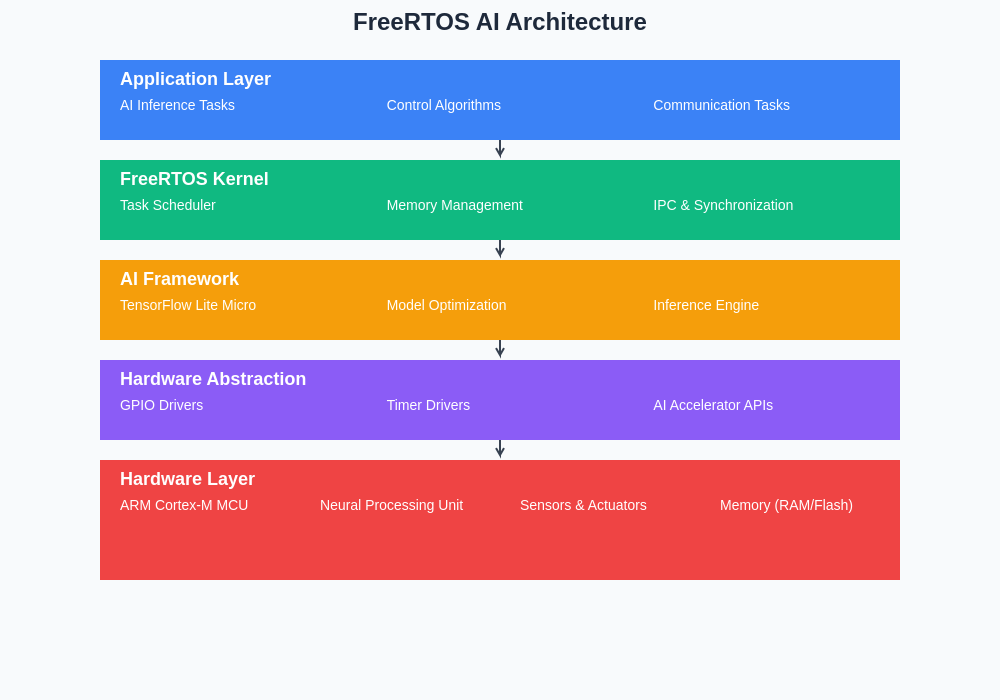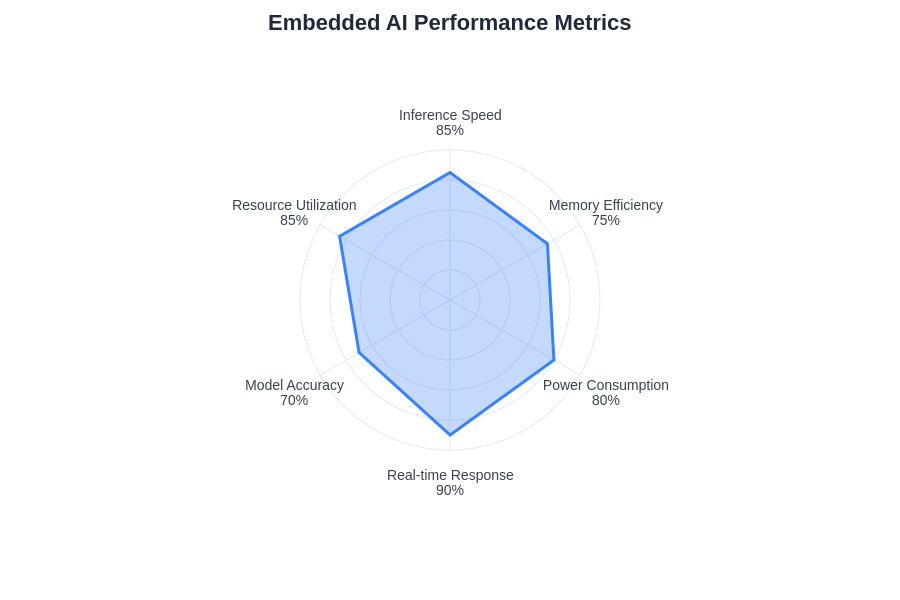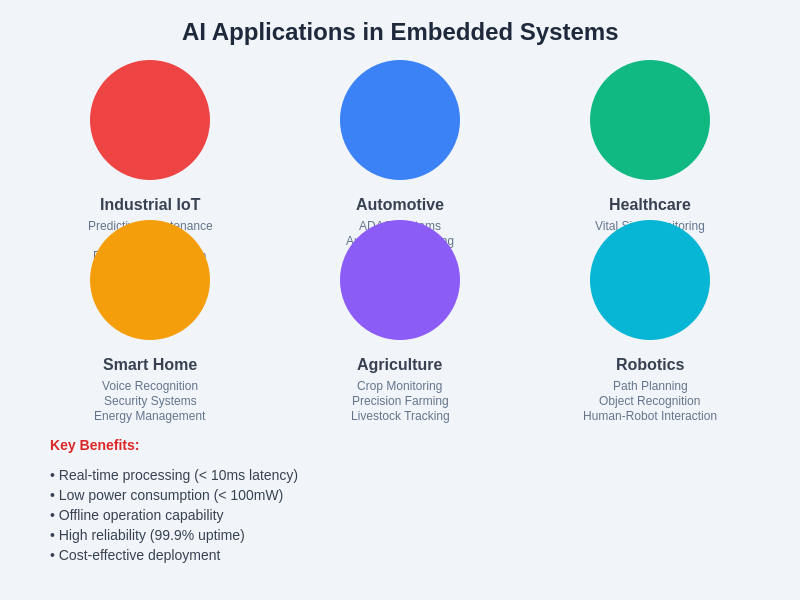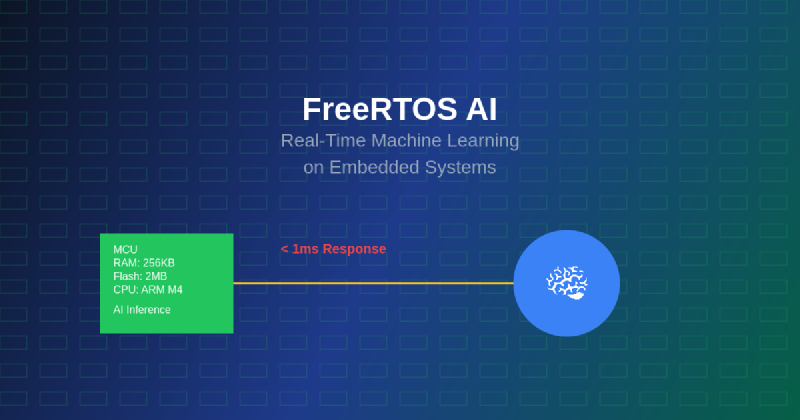The convergence of real-time operating systems and artificial intelligence represents one of the most significant technological advances in embedded computing today. FreeRTOS, the world’s most popular real-time operating system for microcontrollers, has evolved to become a cornerstone platform for implementing machine learning inference at the edge of the network. This revolutionary combination of real-time computing capabilities with AI processing power is transforming industries from autonomous vehicles to smart manufacturing, enabling intelligent decision-making directly on resource-constrained devices without relying on cloud connectivity.
Explore the latest AI trends in embedded systems to understand how artificial intelligence is reshaping the landscape of edge computing and Internet of Things applications. The integration of machine learning capabilities into real-time embedded systems represents a fundamental shift toward distributed intelligence, where smart devices can process data, make decisions, and respond to environmental changes with unprecedented speed and efficiency.
The Evolution of Real-Time AI Processing
The traditional approach to implementing AI in embedded applications required constant connectivity to cloud-based services, introducing latency, bandwidth limitations, and security concerns that made real-time decision-making challenging or impossible. FreeRTOS has emerged as a game-changing platform that enables machine learning inference to occur directly on microcontrollers and embedded processors, eliminating the need for external processing while maintaining the strict timing requirements essential for real-time applications.
This evolution has been driven by advances in both hardware capabilities and software optimization techniques that allow complex neural networks to run efficiently on devices with limited memory, processing power, and energy budgets. The result is a new generation of intelligent embedded systems that can perform sophisticated pattern recognition, predictive analytics, and autonomous decision-making while operating within the stringent constraints of real-time embedded environments.
The democratization of AI processing power through FreeRTOS has opened unprecedented opportunities for creating smart, responsive, and autonomous embedded systems that can adapt to changing conditions, learn from environmental data, and optimize their behavior without human intervention. This capability is particularly valuable in applications where millisecond response times, offline operation, and continuous availability are critical requirements.
Architectural Foundations of FreeRTOS AI
The implementation of artificial intelligence capabilities within FreeRTOS requires careful consideration of the underlying architectural principles that govern real-time system design. The operating system’s preemptive multitasking capabilities provide the foundation for running AI inference engines alongside traditional control algorithms, sensor data acquisition, and communication protocols while maintaining deterministic timing behavior essential for real-time applications.
FreeRTOS achieves this balance through its sophisticated task scheduling mechanisms that allow AI processing tasks to be integrated seamlessly with time-critical control loops and interrupt service routines. The operating system’s memory management capabilities have been enhanced to support the dynamic memory allocation patterns typical of machine learning inference while preventing memory fragmentation that could compromise system reliability and performance.
Discover advanced AI development tools like Claude that can assist in designing and implementing sophisticated embedded AI systems with optimal resource utilization and real-time performance characteristics. The synergy between intelligent development tools and embedded AI platforms accelerates the creation of innovative solutions that push the boundaries of what’s possible in resource-constrained environments.
Machine Learning Inference Optimization
The successful deployment of machine learning models on FreeRTOS-based systems requires extensive optimization to ensure that inference operations can execute within the available computational resources while meeting real-time deadlines. This optimization process involves multiple layers of refinement, including model quantization, pruning, and architectural modifications that reduce computational complexity without significantly compromising accuracy.
Quantization techniques play a crucial role in making neural networks suitable for embedded deployment by converting floating-point operations to fixed-point arithmetic that can be executed more efficiently on microcontroller hardware. Advanced quantization strategies, including dynamic quantization and mixed-precision approaches, enable developers to achieve optimal trade-offs between model accuracy and computational efficiency based on specific application requirements.
Model pruning represents another critical optimization technique that removes redundant neural network parameters and connections, significantly reducing memory requirements and computational overhead while preserving essential model functionality. These pruned models can often achieve performance levels comparable to their full-sized counterparts while requiring substantially fewer resources for inference operations.

The architectural design of FreeRTOS AI systems demonstrates the careful integration of machine learning inference engines with real-time task scheduling, memory management, and hardware abstraction layers. This sophisticated architecture ensures that AI processing can coexist harmoniously with traditional embedded system functions while maintaining deterministic timing behavior.
Hardware Abstraction and Platform Integration
FreeRTOS provides comprehensive hardware abstraction layers that simplify the integration of AI acceleration hardware, specialized neural processing units, and dedicated machine learning accelerators into embedded systems. This abstraction enables developers to leverage hardware-specific optimizations while maintaining portability across different microcontroller families and embedded processor architectures.
The integration of dedicated AI acceleration hardware, such as neural processing units and tensor processing cores, requires careful coordination with FreeRTOS scheduling mechanisms to ensure that accelerated inference operations can be initiated, monitored, and completed within real-time constraints. The operating system’s interrupt handling capabilities facilitate efficient communication between the main processor and specialized AI hardware, enabling optimal utilization of available computational resources.
Modern embedded processors increasingly include dedicated machine learning acceleration features, including specialized instruction sets, vector processing units, and on-chip memory architectures optimized for neural network operations. FreeRTOS has evolved to provide native support for these hardware features, enabling developers to achieve maximum performance from AI-optimized silicon while maintaining the flexibility and reliability characteristics essential for embedded applications.
Real-Time Constraint Management
The implementation of machine learning inference in real-time embedded systems presents unique challenges related to timing predictability, resource allocation, and system responsiveness. FreeRTOS addresses these challenges through advanced scheduling algorithms that can guarantee worst-case execution times for AI inference operations while ensuring that critical system functions maintain their real-time characteristics.
Priority-based task scheduling enables developers to assign appropriate execution priorities to AI inference tasks relative to other system functions, ensuring that time-critical operations receive processor resources when needed while allowing AI processing to utilize available computational capacity during less demanding periods. This dynamic resource allocation approach maximizes system utilization while maintaining deterministic timing behavior.
The operating system’s sophisticated interrupt handling mechanisms enable AI inference operations to be preempted when higher-priority events occur, ensuring that real-time constraints are never violated regardless of the computational complexity of ongoing machine learning operations. This preemptive capability is essential for maintaining system responsiveness in applications where external events require immediate attention.
Enhance your research capabilities with Perplexity to explore the latest developments in real-time AI processing and embedded machine learning optimization techniques. Access to comprehensive research resources accelerates the development of innovative solutions that push the boundaries of embedded AI performance.
Memory Management and Resource Optimization
Effective memory management represents one of the most critical aspects of implementing AI inference on resource-constrained embedded systems. FreeRTOS provides sophisticated memory allocation strategies that accommodate the dynamic memory requirements of machine learning inference while preventing memory fragmentation and ensuring predictable memory usage patterns essential for real-time operation.
The operating system’s heap management capabilities have been enhanced to support the allocation patterns typical of neural network inference, including large contiguous memory blocks for model parameters and intermediate computation results. Advanced memory pool mechanisms enable efficient allocation and deallocation of memory resources without the overhead and unpredictability associated with traditional dynamic memory allocation approaches.
Stack overflow protection and memory usage monitoring capabilities built into FreeRTOS provide essential safeguards against memory-related failures that could compromise system reliability. These monitoring mechanisms enable developers to optimize memory usage patterns and ensure that AI inference operations remain within predefined memory budgets throughout system operation.
Power Management and Energy Efficiency
Energy efficiency represents a paramount concern for battery-powered embedded systems implementing AI inference capabilities. FreeRTOS incorporates sophisticated power management features that enable intelligent control of processor operating frequencies, peripheral device power states, and AI acceleration hardware to minimize energy consumption while maintaining required performance levels.
Dynamic voltage and frequency scaling capabilities allow the operating system to adjust processor performance characteristics based on current computational demands, reducing power consumption during periods of low AI processing activity while ensuring that adequate performance is available when needed. These adaptive power management strategies can significantly extend battery life in portable and remote embedded applications.
The integration of AI inference with power management requires careful consideration of the trade-offs between processing speed, energy consumption, and inference accuracy. FreeRTOS enables developers to implement intelligent power management strategies that adapt to changing application requirements, optimizing energy usage while maintaining acceptable AI performance characteristics.

Performance optimization in embedded AI systems requires careful balancing of multiple competing factors, including inference accuracy, processing latency, memory utilization, and energy consumption. These metrics demonstrate the complex relationships between different optimization strategies and their impact on overall system performance.
Communication Protocols and Connectivity
Modern embedded AI systems frequently require connectivity to external networks for model updates, data synchronization, and remote monitoring capabilities. FreeRTOS provides comprehensive support for various communication protocols, including Wi-Fi, Bluetooth, cellular connectivity, and industrial communication standards that enable seamless integration of AI-powered embedded devices into larger systems and networks.
The operating system’s protocol stack implementations are optimized for embedded environments, providing efficient communication capabilities while minimizing memory footprint and processing overhead. Advanced features such as secure communication protocols, data compression, and adaptive transmission strategies ensure reliable connectivity while preserving system resources for AI processing operations.
Over-the-air update capabilities enable remote deployment of new machine learning models and system software updates without requiring physical access to embedded devices. This capability is essential for maintaining and improving AI performance in deployed systems while reducing maintenance costs and enabling continuous optimization based on real-world usage patterns.
Security Considerations and Trust
The implementation of AI capabilities in embedded systems introduces unique security challenges that must be addressed to ensure system integrity, data privacy, and protection against adversarial attacks. FreeRTOS incorporates comprehensive security features, including secure boot processes, encrypted communication channels, and hardware-based security modules that provide robust protection for AI-powered embedded applications.
Secure model storage and execution environments prevent unauthorized access to machine learning models and protect against model theft or manipulation that could compromise system security. Advanced cryptographic techniques ensure that AI inference operations occur within trusted execution environments that maintain data confidentiality and model integrity throughout the processing pipeline.
The operating system’s security architecture enables implementation of defense mechanisms against adversarial machine learning attacks that could compromise AI inference accuracy or system behavior. These protective measures include input validation, anomaly detection, and model verification techniques that enhance the robustness of AI-powered embedded systems against sophisticated attack vectors.
Development Tools and Ecosystem
The FreeRTOS ecosystem includes comprehensive development tools, debugging capabilities, and simulation environments that streamline the development and deployment of AI-powered embedded applications. These tools enable developers to design, test, and optimize machine learning inference implementations while ensuring compliance with real-time constraints and resource limitations.
Advanced profiling and analysis tools provide detailed insights into AI inference performance, memory usage patterns, and timing behavior that enable developers to identify optimization opportunities and ensure that deployed systems meet performance requirements. These diagnostic capabilities are essential for achieving optimal performance in resource-constrained embedded environments.
The availability of pre-validated machine learning libraries, optimized inference engines, and reference implementations accelerates development timelines while ensuring that AI functionality meets the reliability and performance standards required for embedded applications. These resources enable developers to focus on application-specific functionality rather than low-level optimization details.
Industrial Applications and Use Cases
The combination of FreeRTOS and AI capabilities has enabled transformative applications across numerous industries, from autonomous vehicles and industrial automation to medical devices and smart agriculture. These applications demonstrate the practical benefits of real-time AI processing in environments where traditional cloud-based approaches are inadequate due to latency, connectivity, or reliability requirements.
In automotive applications, FreeRTOS AI enables real-time processing of sensor data for advanced driver assistance systems, autonomous navigation, and predictive maintenance capabilities that enhance vehicle safety and performance. The ability to make critical decisions in milliseconds without relying on external connectivity is essential for ensuring reliable operation in dynamic driving environments.
Industrial automation systems benefit from embedded AI capabilities that enable predictive maintenance, quality control, and adaptive process optimization based on real-time analysis of sensor data and system performance metrics. These applications require the deterministic timing and reliability characteristics that FreeRTOS provides while leveraging AI capabilities to improve efficiency and reduce operational costs.

The diverse applications of AI in embedded systems span multiple industries and use cases, each requiring specific optimizations and design considerations to achieve optimal performance within the constraints of real-time embedded environments.
Future Trends and Evolution
The continued evolution of FreeRTOS AI capabilities is being driven by advances in both hardware technology and machine learning algorithms that enable increasingly sophisticated AI applications on embedded platforms. Emerging trends include federated learning implementations that enable collaborative model training across distributed embedded devices, adaptive neural architectures that optimize themselves based on deployment conditions, and neuromorphic computing approaches that promise dramatic improvements in energy efficiency.
The integration of quantum computing principles into embedded AI processing represents a longer-term opportunity that could revolutionize the computational capabilities available in resource-constrained environments. While practical quantum computing implementations for embedded systems remain in early research phases, the fundamental principles offer promising directions for future development.
The standardization of AI processing interfaces and model formats is enabling greater interoperability between different embedded platforms and development tools, facilitating the creation of portable AI applications that can be deployed across diverse hardware architectures while maintaining optimal performance characteristics.
Performance Optimization Strategies
Achieving optimal performance in FreeRTOS AI implementations requires systematic application of optimization strategies that address multiple aspects of system design, from algorithmic efficiency to hardware utilization. These strategies include careful selection of neural network architectures that balance accuracy requirements with computational constraints, implementation of efficient data processing pipelines that minimize memory bandwidth requirements, and optimization of task scheduling parameters that ensure real-time constraints are met consistently.
The use of mixed-precision arithmetic enables significant performance improvements by utilizing appropriate numerical representations for different parts of neural network computations, reducing memory requirements and computational overhead while maintaining acceptable accuracy levels. Advanced compiler optimizations and code generation techniques further enhance performance by generating highly efficient machine code optimized for specific target hardware architectures.
Profiling and performance analysis tools enable developers to identify bottlenecks and optimization opportunities throughout the development process, ensuring that final implementations achieve maximum performance within available resource constraints. These analytical approaches are essential for validating that deployed systems meet performance requirements under worst-case operating conditions.
Deployment and Production Considerations
The transition from development to production deployment of FreeRTOS AI systems requires careful attention to reliability, maintainability, and scalability considerations that ensure successful operation in real-world environments. These considerations include comprehensive testing strategies that validate AI performance under diverse operating conditions, implementation of robust error handling mechanisms that maintain system stability when AI inference operations encounter unexpected conditions, and establishment of monitoring and diagnostic capabilities that enable remote system health assessment.
Quality assurance processes for AI-powered embedded systems must address both traditional embedded system reliability requirements and AI-specific concerns such as model accuracy degradation, adversarial input handling, and graceful performance degradation under resource constraints. These comprehensive testing approaches ensure that deployed systems maintain acceptable performance characteristics throughout their operational lifetime.
The scalability of FreeRTOS AI implementations enables deployment across device families ranging from simple microcontrollers to complex multi-core embedded processors, providing flexibility for addressing diverse application requirements while maintaining consistent development approaches and performance characteristics.
The revolutionary impact of FreeRTOS AI on embedded systems development continues to accelerate as hardware capabilities improve and machine learning algorithms become more efficient. This convergence of real-time computing and artificial intelligence represents a fundamental shift toward intelligent, autonomous embedded systems that can adapt to changing conditions, optimize their behavior, and provide unprecedented capabilities in applications ranging from consumer electronics to mission-critical industrial systems. The future of embedded computing lies in this intelligent integration of real-time processing capabilities with machine learning inference, enabling the creation of systems that are not only responsive and reliable but also inherently intelligent and adaptive.
Disclaimer
This article is for informational purposes only and does not constitute professional advice. The views expressed are based on current understanding of FreeRTOS and embedded AI technologies and their applications in real-time systems. Readers should conduct their own research and consider their specific requirements when implementing AI capabilities in embedded systems. The effectiveness of embedded AI solutions may vary depending on specific use cases, hardware platforms, and application requirements. Always consult official documentation and conduct thorough testing before deploying AI-powered embedded systems in production environments.
